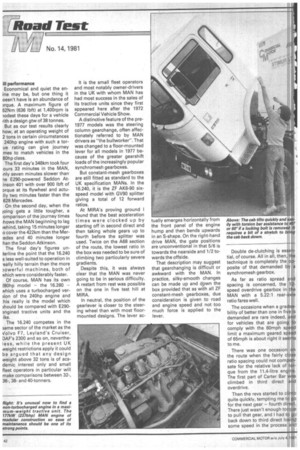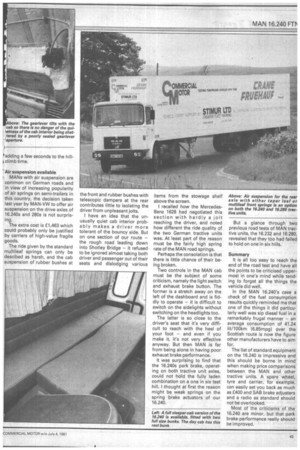Road Test
Page 30

Page 31

If you've noticed an error in this article please click here to report it so we can fix it.
//I / No.14,1981
ill performance Economical and quiet the enine may be, but one thing it oesn't have is an abundance of nque. A maximum figure of 62Nm (636 Ibft) at 1,400rpm is lodest these days for a vehicle rith a design gtw of 38 tonnes. But as our test results clearly how, at an operating weight of 2 tons in certain circumstances 240hp engine with such a true rating can give journey mes to match vehicles in the 80hp class.
The first day's 348km took four ours 33 minutes in the MAN, nly seven minutes slower than ie E290-powered Seddon Atinson 401 with over 900 lbft of Drque at its flywheel and actuIly two minutes faster than the 628 Mercedes.
On the second day, when the long gets a little tougher, a omparison of the journey times ihows the MAN beginning to lag aehind, -taking 15 minutes longer o cover the 422km than the Meriedes and 40 minutes longer han the Seddon Atkinson.
The final day's figures unierline the point that the 16.240 s less well-suited to operation in ieally hilly terrain than the more )owerful machines, both of which were considerably faster.
Of course, MAN has its own ?.80hp model — the 16.280 — which uses a turbocharged version of the 240hp engine and his really is the model which ;hould be compared with E290?,ngined tractive units and the ike.
The 16.240 competes in the same sector of the market as the Volvo F7, Leyland's Cruiser, DAF's 2300 and so on, nevertheless, while the present UK weight restrictions apply it could be argued that any design weight above 32 tons is of academic interest only and small fleet operators in particular will make comparisons between 32-, 36-, 38and 40-tonners. It is the small fleet operators and most notably owner-drivers in the UK with whom MAN has had most success in the sales of its tractive units since they first appeared here after the 1972 Commercial Vehicle Show.
A distinctive feature of the pre1977 models was the steering column gearchange, often affectionately referred to by MAN drivers as "the bullworker". That was changed to a floor-mounted lever for all models in 1977 because of the greater gearshift loads of the increasingly popular synchromesh gearboxes.
But constant-mesh gearboxes are still fitted as standard to the UK specification MANs. In the 16.240, it is the ZF AK6-90 sixspeed model with GV90 splitter giving a total of 12 forward ratios.
At MIRA's proving ground I found that the best acceleration times were clocked up by starting off in second direct and then taking whole gears up to fourth before the splitter was used. Twice on the A68 section of the route, the lowest ratio in the box was needed to be sure of climbing two particularly severe gradients.
Despite this, it was always clear that the MAN was never going to be in serious difficulty. A restart from rest was possible on the one in five test hill at MIRA.
In neutral, the position of the gearlever is closer to the steering wheel than with most floormounted designs. The lever ac tually emerges horizontally from the front panel of the engine hump and then bends upwards in an S-shape. On the right-hand drive MAN, the gate positions are unconventional in that 5/6 is towards the nearside and 1/2 towards the offside.
That description may suggest that gearchanging is difficult or awkward with the MAN. In practice, silky-smooth changes can be made up and down the box provided that as with all ZF constant-mesh gearboxes, due consideration is given to road and engine speed and not too much force is applied to the lever. Double de-clutching is essential, of course. All in all, then, the technique is completely the opposite of that demanded by a synchromesh gearbox.
As far as ratio spread and spacing is concerned, the 12speed overdrive gearbox in the MAN with a 5,22:1 rear-axle ratio fares well.
The occasions when a gradeability of better than one in five is demanded are rare indeed, and for vehicles that are going to comply with the 60mph speed limit a maximum geared speed of 65mph is about right it seems to me.
There was one occasion on the route when the fairly close ratio spacing could not compensate for the relative lack of torque from the 11.4-litre engine. The first part of Carter Bar was climbed in third direct and overdrive.
Then the revs started to climb quite quickly, tempting me to go for the next gear — fourth direct. There just wasn't enough torque to pull that gear, and I had to go back down to third direct losing some speed in the process and Air suspension available 'adding a few seconds to the hillclimb time.
MANs with air suspension are common on German roads and in view of increasing popularity of air springs on semi-trailers in this country, the decision taken last year by MAN-VW to offer air suspension on the drive axles of 16.240s and 280s is not surprising, The extra cost is £1,463 which could probably only be justified by carriers of high-value fragile goods.
The ride given by the standard multileaf springs can only be descibed as harsh, and the cab suspension of rubber bushes at the front and rubber bushes with telescopic dampers at the rear contributes little to isolating the driver from unpleasant jolts.
I have an idea that the unusually quiet cab interior probably makes a driver more tolerant of the bouncy side. But on one section of our route — the rough road leading down into Shotley Bridge — it refused to be ignored almost taking both driver and passenger out of their seats and dislodging various items from the stowage shelf above the screen.
I recalled how the MercedesBenz 1628 had negotiated this section with hardly a jolt reaching the driver, and noted how different the ride quality of the two German tractive units was. At least part of the reason must be the fairly high spring rate of the MAN road springs.
Perhaps the consolation is that there is little chance of their being broken.
Two controls in the MAN cab must be the subject of some criticism, namely the light switch and exhaust brake button. The former is a stretch away on the left of the dashboard and is fiddly to operate — it is difficult to switch on the sidelights without switching on the headlights too.
The latter is so close to the driver's seat that it's very difficult to reach with the heel of your foot — and even if you make it, it's not very effective anyway. But then MAN is far from being alone in having poor exhaust brake performance.
It was surprising to find that the 16.240s park brake, operating on both tractive unit axles, could not hold the fully laden combination on a one in six test hill. I thought at first the reason might be weak springs on the spring brake actuators of our 16.240. But a glance through two previous road tests of MAN tractive units, the 16.232 and 16.280, revealed that they too had failed to hold on one in six hills.
Surnmary It is all too easy to reach the end of the road test and have all the points to be criticised uppermost in one's mind while tending to forget all the things the vehicle did well.
In the MAN 16.240's case a check of the fuel consumption results quickly reminded me that one of the things it did particularly well was sip diesel fuel in a remarkably frugal manner — an average consumption of 41,24 lit/100km (6.85mpg) over the Scottish route is now the figure other manufacturers have to aim for.
The list of standard equipment on the 16.240 is impressive and this should be borne in mind when making price comparisons between the MAN and other tractive units, A spare wheel, tyre and carrier, for example, can easily set you back as much as £400 and SAB brake adjusters and a radio as standard should not be overlooked.
Most of the criticisms of the 16.240 are minor, but that park brake performance really should be improved.












































